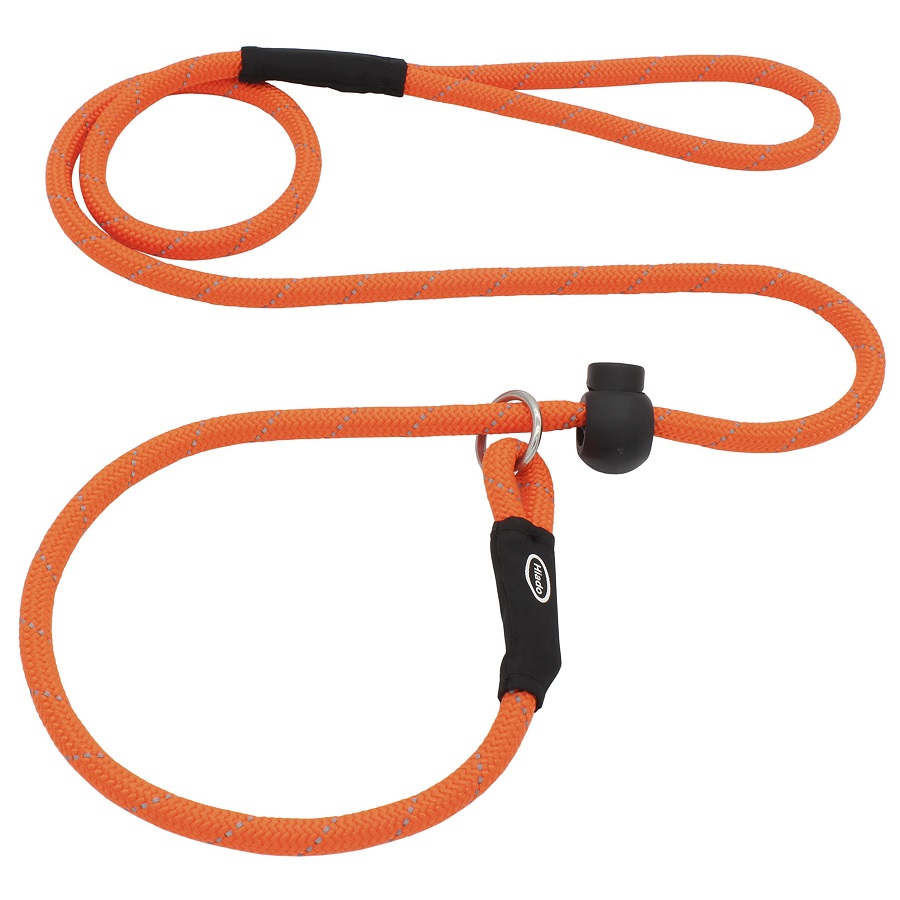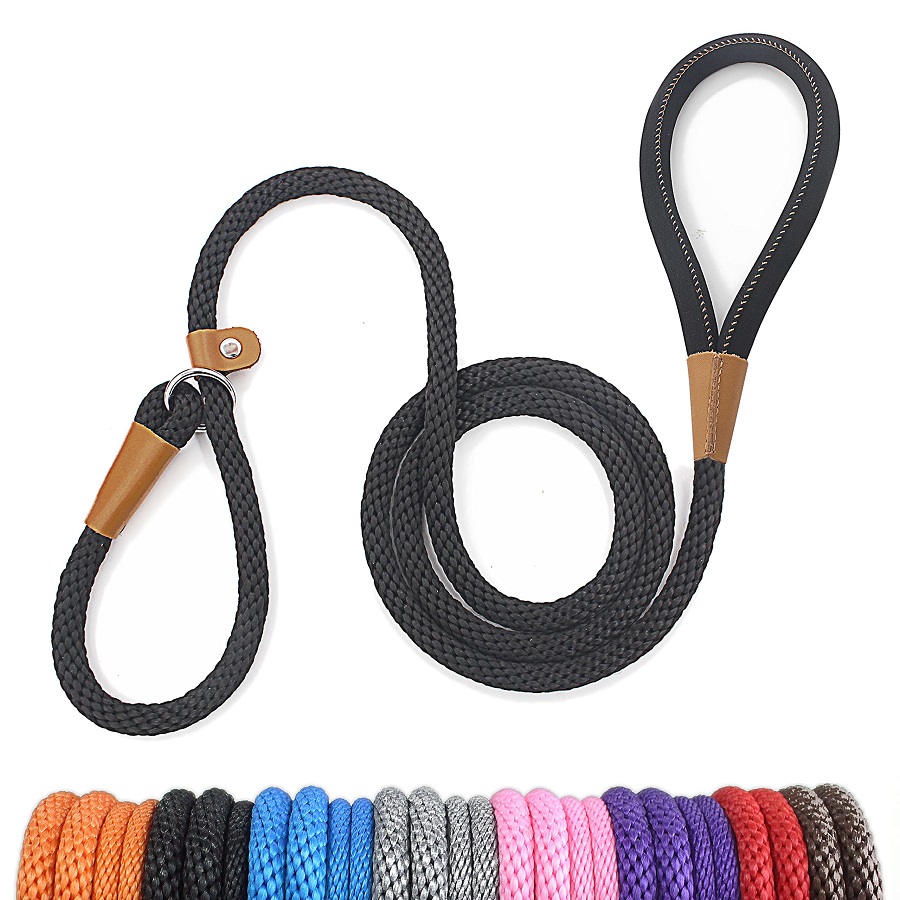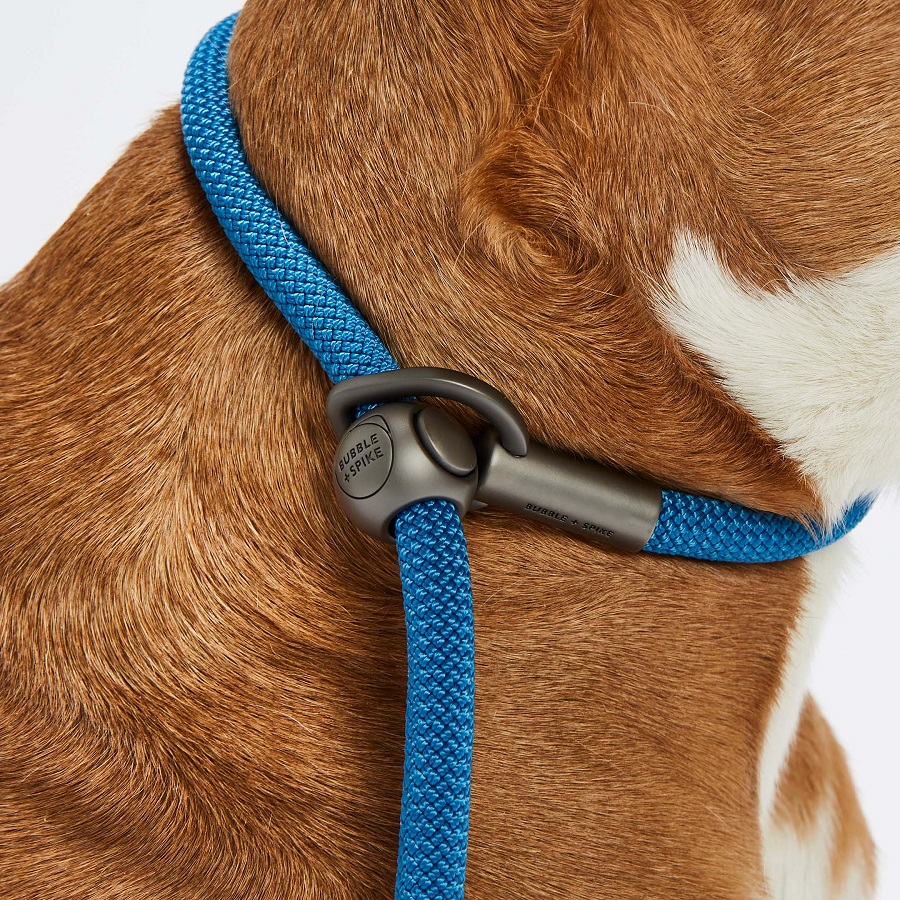What Are Slip Leashes and How Do They Work
Slip leashes are a type of dog leash with a unique design. They combine a collar and leash into one piece. This design uses a loop that slips over the dog’s head. It tightens when the dog pulls but releases when they stop. This helps to prevent escape and encourages better walking habits.
To use a slip leash, place the loop over the dog’s head. Adjust it to fit comfortably just above their shoulders. When your dog stays by your side, the leash remains loose. If they attempt to run or pull, the leash tightens around their neck. This tightening is a gentle reminder to your dog to slow down or stop. It’s essential for the dog’s safety that the leash is used properly.
Slip leashes are made from various materials, like nylon or leather. They come in different lengths and thicknesses. Some have stoppers to prevent too much tightening. It’s important to select a slip leash that suits your dog’s size and strength. Proper use is key to making slip leashes work effectively for training and walking.
Benefits of Using a Slip Leash for Your Dog
Slip leashes offer several advantages for dog owners. Firstly, they provide a quick and easy way to control your dog without needing a separate collar. This is especially helpful in situations where you need to fasten or release your dog swiftly. As they serve as both a collar and leash, slip leashes reduce the clutter of extra equipment.
Another benefit is the built-in training mechanism. The design encourages dogs to walk calmly by their owner’s side. When a dog pulls or tries to run off, the leash tightens. This creates a natural cue for the dog to slow down. With consistent training, dogs begin to understand boundaries easier, leading to better walking behaviors.
Safety is a major plus with slip leashes. With the right size and correct fitting, they can prevent dogs from slipping out of collars. This is crucial when navigating through busy streets or crowded areas. The tightening mechanism provides additional security without causing harm when used correctly.
Also, slip leashes are versatile. They’re useful in various settings, from casual walks to more structured training sessions. Many professional trainers use slip leashes for their simplicity and effectiveness in teaching discipline.
Finally, slip leashes are often more affordable than buying a collar and leash separately. This makes them an economical choice for many pet owners. Plus, their simplicity means they’re easy to clean and maintain, making a slip leash a practical addition to your dog’s accessories.

Selecting the Right Slip Leash for Your Dog
Selecting the ideal slip leash for your dog involves several factors. It’s not just about choosing a leash that looks good; it’s about finding a slip leash that ensures your dog’s safety and comfort during walks and training sessions. Here are some key considerations to help you find the perfect match for your furry friend:
- Measure Your Dog: Check your dog’s neck size before buying a slip leash. It should fit snugly without causing discomfort.
- Consider the Material: Slip leashes come in materials like nylon and leather. Nylon is durable and easy to clean, while leather offers a classic look and can be more comfortable with age.
- Look at the Length: The right length allows for easy control without tripping over. A common length is six feet, but this may vary depending on your dog’s size and training needs.
- Check for Features: Some slip leashes have features like reflective stitching for nighttime safety or stoppers to limit tightening. Choose features that suit your walking and training routines.
- Think about Strength: A strong slip leash is a must for larger breeds or strong pullers. Ensure the leash’s thickness and material are suitable for your dog’s power.
- Mind the Weight: Heavier leashes might be uncomfortable for small dogs. Opt for a lighter version if you have a smaller breed.
Choosing the right slip leash is crucial for both safety and training effectiveness. Take the time to assess your needs and your dog’s characteristics to ensure a perfect match. Remember, proper use of slip leashes can significantly improve walking habits over time, so select wisely for the best results.
Tips for Training Your Dog with a Slip Leash
When using slip leashes for dog training, some pointers can help achieve the best outcomes. Training your dog with a slip leash requires consistency, patience, and the correct technique. Here are some tips to guide you:
- Start with Short Sessions: Begin with short training intervals. Gradually increase time as your dog gets used to the leash.
- Stay Consistent: Use the same commands and actions each time. This helps your dog learn what to expect.
- Correct Timing: Apply gentle pressure when your dog pulls. Release it as soon as they slow down.
- Positive Reinforcement: Reward your dog for walking nicely. Treats or praise can encourage good behavior.
- Don’t Over-Tighten: Avoid setting the leash too tight. It should be snug but not uncomfortable.
- Practice in a Safe Area: Start in a quiet place with few distractions. Move to busier areas as your dog improves.
- Be Patient: Training takes time. Don’t rush the process or get frustrated.
- Monitor Your Dog’s Response: Watch for signs of discomfort or anxiety. Adjust the training approach if needed.
- Combine with Verbal Cues: Pair leash cues with verbal commands. This reinforces the training.
Training with slip leashes can improve your dog’s walking behavior. Remember to use them responsibly and always prioritize your dog’s well-being. Successful training with a slip leash can lead to enjoyable, stress-free walks for both you and your canine companion.

Potential Drawbacks and How to Avoid Them
While slip leashes are useful, they are not without potential issues. It’s important to know these drawbacks. Knowledge helps us prevent them. Here are some common concerns and how to avoid them:
- Risk of Choking: If misused, a slip leash can tighten too much. Always watch your dog’s breathing. Adjust the leash to allow for a relaxed fit. Ensure there’s enough space for two fingers to fit between the leash and your dog’s neck. This way, you can prevent choking hazards.
- Skin Irritation: Constant rubbing can irritate your dog’s skin. Choose a slip leash with a soft material. Inspect your dog’s neck regularly for any signs of irritation. If redness or sores appear, consider a leash with padding or give your dog a break from the slip leash.
- Escape Attempts: Some dogs may slip out if the leash is too loose. Use stoppers to secure the right fit. Training your dog to respond to leash pressure helps too. This way, your pet learns not to pull or try escaping.
- Over-correction: Pulling the leash too hard can scare or harm your dog. Use a gentle tug as a cue. Always pair it with positive reinforcement like treats or praise. Encourage good habits without instilling fear.
- Lack of Control: In emergency situations, slip leashes offer less control than traditional ones. Be vigilant in high-risk settings. Practice commands like ‘stay’ and ‘heel’ to maintain control. Consider a backup collar for added security in such instances.
Understanding and preventing the drawbacks of slip leashes is vital. It ensures the safety and happiness of your four-legged friend. With careful use and proper training, slip leashes are a great tool. They improve walking habits and strengthen the bond with your dog.
Slip Leash vs. Traditional Leashes: A Comparison
When deciding between a slip leash and traditional leash, you need to weigh various factors. Here’s a straightforward comparison to help you understand their differences.
- Ease of Use: Slip leashes are easy to put on and take off. They slip over the dog’s head without fuss. Traditional leashes require a collar and securing the leash clip.
- Training: Slip leashes can aid in training, gently correcting your dog when they pull. Traditional leashes may not provide this level of training support without additional tools.
- Adjustability: Slip leashes adjust to your dog’s neck, fitting various sizes. Traditional leashes have a fixed length and rely on the collar for any adjustment.
- Quick Control: With a slip leash, you get quick control over your dog. This can be crucial in busy areas. Traditional leashes offer steady control but can be less immediate.
- Safety: Both types of leashes can be safe when used correctly. However, slip leashes pose a risk of choking if not used properly. Make sure they fit well and observe your dog’s comfort.
- Comfort: Slip leashes can be less comfortable for dogs prone to neck sensitivity. Traditional collars and leashes can offer more comfort with padded options.
- Escape-Proof: A properly used slip leash can be more secure, reducing the risk of your dog escaping. Traditional leashes might not prevent a skilled escape artist from slipping their collar.
Understanding these key points will assist you in making the best choice for your dog. Whether you prefer the training benefits of slip leashes or the tradition and simplicity of regular leashes, prioritize your dog’s comfort and safety.

Caring for Your Slip Leash: Maintenance and Longevity
To make sure your slip leash lasts a long time, here are some care tips:
- Clean Regularly: Wipe down your slip leash after each use. This removes dirt and grime. For nylon leashes, use soapy water and a soft cloth. Leather leashes may need a specialized cleaner.
- Check for Damage: Inspect your leash for any signs of wear. Look for frayed edges or weak spots. Replace the leash if you find any damage that could affect its strength.
- Keep Dry: Let your slip leash air dry if it gets wet. Avoid leaving it in direct sunlight or heat. This prevents the material from weakening.
- Store Properly: Hang your slip leash in a cool, dry place away from direct sunlight when not in use. This helps maintain its shape and functionality.
- Avoid Chemicals: Keep your slip leash away from harsh chemicals. These can break down the materials over time.
- Condition Leather: If your slip leash is leather, condition it occasionally. This keeps it flexible and prevents cracking.
- Follow Manufacturer’s Instructions: Always check the care label or instructions that come with your slip leash. Different materials might need specific care methods.
By taking care of your slip leash, you ensure it remains a reliable tool for controlling and training your dog. A well-maintained leash can provide safety and comfort for both you and your pet during walks.
Top Slip Leash Brands and What to Look For
When you’re in the market for a slip leash, certain brands stand out for their quality and innovation. Selecting from top brands can often assure you of a quality product that meets your dog training and safety needs. Along with brand reputation, there are specific features to consider ensuring you choose a slip leash that’s right for your dog.
- Durability: Look for brands known for making strong, long-lasting slip leashes. They should withstand daily use.
- Material Quality: High-grade nylon or premium leather are signs of a quality leash. These materials can offer both durability and comfort.
- Comfort and Safety Features: Some brands offer padded handles or reflective stitching for added comfort and safety during walks.
- Adjustability: A good slip leash offers easy adjustment to fit your dog snugly. Brands offering adjustable stoppers can add to the leash’s safety.
- Customer Reviews: Checking what other pet owners say can be insightful. Brands with positive feedback often deliver on their promises.
- Price Point: While expensive doesn’t always mean better, be wary of very cheap leashes. They may not offer the quality or safety your dog needs.
- Warranty or Guarantee: Brands that stand behind their products with a warranty are often more reliable. This can offer peace of mind in your purchase.
- Ethical Practices: Some brands are committed to sustainable and ethical manufacturing processes. If this is important to you, look for leashes from companies with these values.
Among top brands you might encounter are Mendota Pet, Max and Neo, and PetSafe. They often provide a variety of slip leashes that tick many of the boxes above. Remember, the key to finding the ideal slip leash is ensuring it matches your dog’s specific needs and training habits. With the right research and consideration of the points listed, you and your furry friend can enjoy safe and effective training and walking experiences.










